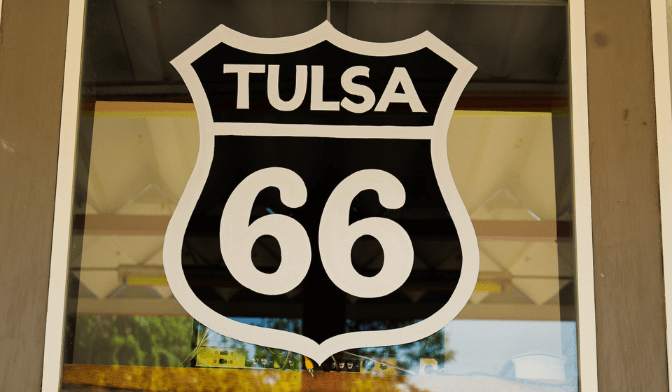Sooner State Resurgence: The moveBuddha 2023 Oklahoma Migration Report

The migration tides are turning in Oklahoma. The Sooner State has long been in the shadow of neighboring Texas, but it’s facing a resurgence. Oklahoma’s gains in net domestic migration in 2021 were the highest since at least 1999. 2022 was a great year, too. moveBuddha data shows that Oklahoma ranked 11th for the most move-in interest nationwide in 2022 and 15th in early 2023.
Big Takeaways
- Oklahoma was ranked 11th for the most move-in search interest in 2022 and sits at 15th for the highest move-in interest in early 2023.
- Oklahoma is primarily trading residents with Texas, California, and Florida, especially the Lone Star State. Texans showed the most interest in moving to Oklahoma in 2022. But Texas was also the top state for Oklahomans to express moving interest in last year.
- Eight of the 11 Oklahoma cities we studied saw either positive or neutral move-in interest in 2022. Tulsa was the most popular city that potential movers searched in 2022, with a move-in-to-move-out ratio of 1.9.
- Claremore in the Tulsa metro area had the worst move-in-to-move-out search volume ratio in Oklahoma in 2022, with a rate of 0.72.
The Oklahoma Brain Drain is Over
Oklahoma is on a hot streak.
In 2021, the Sooner State was one of 16 states nationwide that added over half a percent to its population from net domestic migration. Nearly 25,000 more people moved into Oklahoma than moved out from July 2020 to July 2021. This rate was about twice as high as the previous year and has continued an accelerating upward trend for Oklahoma migration since 2019.
This recent boom in in-move migration reverses an outward trend Oklahoma suffered before 2019. Between 2016 and 2018, Oklahoma saw a significant amount of outward net migration, especially among college graduates.
Now, the shift upward is on – and the brain drain is over. Oklahoma’s inflow-to-outflow search volume ratio in the moveBuddha calculator has steadily improved since 2020.
The move-in-to-move-out search volume ratio was a healthy 1.54 in 2022. That means that for every 100 people who searched for moves out of Oklahoma, 154 were considering moving to the state last year. That put Oklahoma right behind states like Florida and Tennessee for the most positive ratios.
Several factors could be contributing to renewed interest in Oklahoma. In the state’s two biggest metropolitan areas, Tulsa and Oklahoma City, there has been a steady drumbeat of economic and migration growth.
Since 2018, Tulsa has made news by offering remote workers $10,000 to move to the city for at least a year. About 950 people took Tulsa up on the offer in 2021. Many of them have stayed. This is reflected in the moveBuddha data, with Tulsa seeing the most positive volume of move-in searches in 2022 (1.9).
Let’s dig deeper into the moveBuddha data to see how Oklahoma’s migration numbers stack up nationwide and which cities are seeing the most interest.
f
Table of Contents:
I. Oklahoma Moves: Statewide trends from the last decade and into 2022
II. 2022 Forecast: Which Oklahoma cities are surging in popularity, and which are losing the most residents?
III. Sources and Methodology
I. Welcome to Oklahoma

Some folks may be surprised to hear of all the moves to Oklahoma. But the resurgence in interest has been steady since 2019. The state’s brain drain from 2013 to 2019 stopped in the pandemic year of 2020. More bachelor’s degree holders began staying and moving into the state than leaving.
The net result of this and other trends in 2021 was the highest overall Oklahoma population growth in six years. That’s despite the state being hit particularly hard by COVID-19 deaths in 2020 and 2021. moveBuddha data backs up these trends, showing a 1.42 inflow-to-outflow ratio for Oklahoma in 2021. The good times rolled in 2022 and 2023, with ratios of 1.54 and 1.40, respectively.
What may be driving the moves into Oklahoma?
- An influx of Texans and Californians. Texans and Californians moved to the Sooner State at historic rates in 2020 and 2021. Oklahoma saw a net gain of about 8,500 Californians and 7,300 Texans in those years. Other states showing increased interest are Colorado and Arizona.
- Growing metro areas. Tulsa is growing fast, but Oklahoma City is one of the fastest-growing large cities in America. Oklahoma City recently climbed past Boston to become the nation’s 20th-largest city by population. In recent decades, OKC has spent millions of dollars to remake the city, adding new parks, a streetcar system, and a brand-new basketball arena.
- Diverse and robust city economies. Many parts of Oklahoma rely heavily on the energy industry, but not all. Large areas like Tulsa also specialize in services industries, which have seen the most growth nationwide in the past decade. Tulsa’s economy also specializes in key sectors like transportation and warehousing, information technology, professional and business services, and health care.
Where are new Oklahoma residents coming from?
The top states moving to Oklahoma are Texas (17.2%), California (15.6%), and Florida (6.4%).
It’s not shocking that Texans were most interested in moving to Oklahoma in 2022. The two states border each other and have a long history of trading residents. A move from Texas to Oklahoma is likely far less expensive and challenging than moving from, say, Maine to Oklahoma.
It should also be noted that nearly 15% of the move searches for out of Oklahoma last year were for Texas. Florida was the next most searched state for Oklahoma residents, at 7.1%.
The huge interest of Californians in Oklahoma seems like more of a head-scratcher, but not necessarily. California was the top exodus state in 2022, according to moveBuddha data. Among all U.S. states, California had the worst ratio (0.51) of people searching for moves out versus moves in.
Californians have been searching for moves across the U.S. They are landing in states as diverse as New York, Florida, and Oregon. Oklahoma is one of the many destinations that fleeing California residents are considering.
II. 2022 Moves: Which Oklahoma cities are surging in popularity, and which are losing the most residents?

Analyzing searches from the moveBuddha Moving Calculator in 2022, we identified all the Oklahoma cities that moveBuddha users are searching, whether to move into or out of.
Limiting these results to cities with at least 25 inbound searches and 25 outbound searches to avoid outliers, we honed in on 11 Oklahoma cities seeing the most activity.
Of the 11 cities we analyzed, 8 had positive or neutral move-in-to-move-out ratios. The cities with the highest positive move ratios are #1 Tulsa (190 to 100), #2 Edmond (123 to 100), and #3 Broken Arrow (121 to 100).
The cities with the highest negative ratios were #11 Claremore (72 to 100), #10 Bray (79 to 100), and #9 Lawton (98 to 100).
A New Kind of Energy in Tulsa
The fact that Tulsa saw the highest move-in search volume in the state in 2022 shouldn’t surprise most Oklahoma residents. The U.S. Census says about 7,000 people moved to Tusla in 2021, and many are calling it the next boom town.
The Tulsa metropolitan area now tops 1 million people and is growing faster than most of the country. Big companies from states like Texas and Colorado are moving their headquarters to Tulsa, bringing more people and jobs.
Many believe Tulsa’s resurgence began in 2018 when the George Kaiser Family Foundation and Tulsa Remote started recruiting remote workers to move to the city. The Tulsa region is estimated to grow by almost 6% or 63,000 people between 2021 and 2027. The moveBuddha data that shows the vast interest in Tulsa in 2022 verify this trend and how the area is red-hot.
Suburban Growth
The popularity of #3 Broken Arrow also makes sense. Broken Arrow is the largest suburb in the Tulsa MSA and the fourth-largest city in Oklahoma.
Initially, it was an agricultural community, but its economy has become very diverse. Broken Arrow has the third-largest concentration of manufacturers in the Sooner State.
#2 Edmond was also a popular Oklahoma move-in search in 2022. Edmond is part of the Oklahoma City MSA, and its population grew 16% from 2010 to 2020, according to the U.S. Census. That made it the fifth-largest city in Oklahoma. The city has consistently grown over the past few decades and is also home to the University of Central Oklahoma.
OKC brings the Thunder
Let’s not forget about Oklahoma City. OKC is the capital of Oklahoma and the state’s largest city, growing by leaps and bounds. OKC’s population spiked by more than 17% between 2010 and 2020.
moveBuddha data shows that move-in interest to OKC was tepid in 2022; this may only be a temporary blip in the numbers. The move-in-to-move-out search volume ratio for Oklahoma City was still a positive 1.06 last year.
Is Oklahoma the Next Texas?

Oklahoma wants to be the next Texas. And by that, we mean they want to see the same booming inflow migration numbers as their rival state to the south.
The Sooner State still has a long way to go to achieve that goal. But based on the moveBuddha migration data since 2020, they are well on their way.
Oklahoma and Texas have long been rivals both economically and in sports. But Oklahoma is following the same low-tax, high-growth economic playbook as the Lone Star state to draw in more residents, which appears to be working.
A Red River rivalry in migration is brewing. It was showcased in 2020 when Elon Musk visited Tulsa and was considering moving Tesla’s headquarters there. Musk eventually decided on Austin, Texas. But the fact that Tulsa was even considered was a win for many in Oklahoma.
Most of the migration growth in Oklahoma is happening in the two major metro areas of Tulsa and Oklahoma City. But even smaller metros, “micropolitan” areas, and rural areas are reversing a decades-long outflow of residents.
According to the Oklahoma Economist, fifty-eight of Oklahoma’s 77 counties saw positive net domestic migration numbers for 2021.
Oklahoma has been a state long reliant on the energy and agricultural industries. Still, the state’s economy is becoming more diverse. The Tulsa Remote program that has paid workers to relocate there is just one example of the success some of the state’s cities have been having in recent years.
Can Oklahoma continue its inflow migration hot streak? Only time will tell. In the meantime, the moveBuddha data shows the Sooner State is attracting new residents across the U.S. - from California to Virginia.
III. Sources and Methodology
This report primarily uses data sourced from moveBuddha’s Moving Cost Calculator with additional city-specific details from the U.S. Census Bureau. We refer to Zillow data to understand the cost of area homes and area rental costs.
moveBuddha proprietary data
This data was collected from January 1, 2022, through December 31, 2022, and includes searches nationwide by individuals who were either planning to move or hire a moving company throughout 2022. We also include a reference to data collected in January 2023.
More information about our move data and in-to-out ratio equation can be found in our annual Migration Report.
U.S. Census Bureau data
Unless otherwise indicated, supplemental city-specific data was sourced from:
- U.S. Census Population Data: Population data
- American Community Survey: Median income, median age, college education percentages, and the unemployment rate
Zillow — Zillow Home Value Index (ZHVI) and Zillow Observed Rent Index (ZORI)
The Zillow Home Value Index or ZHVI provides the typical single-family home value within each city at a given time.
The Zillow Observed Rent Index or ZORI provides the "smoothed measure of the typically observed market rate rent across a given region."
Not what you were looking for?
Check out other categories that can help you find the information you need!

